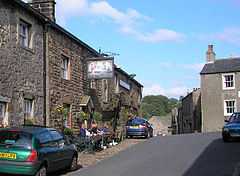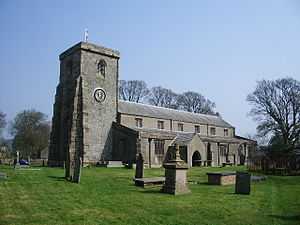Slaidburn
| Slaidburn | |
 The 'Hark to Bounty', Slaidburn |
|
 Slaidburn |
|
| Population | 288 (2001 Census) |
|---|---|
| OS grid reference | SD715525 |
| District | Ribble Valley |
| Shire county | Lancashire |
| Region | North West |
| Country | England |
| Sovereign state | United Kingdom |
| Post town | CLITHEROE |
| Postcode district | BB7 |
| Dialling code | 01200 |
| Police | Lancashire |
| Fire | Lancashire |
| Ambulance | North West |
| EU Parliament | North West England |
| UK Parliament | Ribble Valley |
|
|
Coordinates: 53°58′04″N 2°26′09″W / 53.967783°N 2.435927°W
Slaidburn is a village and civil parish within the Ribble Valley district of Lancashire, England. With a population in 2001 of just under 300, the parish covers just over 5,000 acres of the Forest of Bowland.[1] Historically in the West Riding of Yorkshire, Slaidburn lies near the head of the River Hodder and Stocks Reservoir, both within the Forest of Bowland, an Area of Outstanding Natural Beauty. Farming is still a major employer, but the area attracts tourists; for walking in particular. The civil parish of Slaidburn shares a parish council with Easington, a rural parish to the north of Slaidburn.[2]
The parish church of St Andrew has a superb Jacobean screen and a fine Georgian pulpit. The brass band composer William Rimmer (1862–1936) composed the now-popular march, named Slaidburn after the village, for the Slaidburn Silver Band. A new village hall has opened to much fanfare and is being well used.[3] There is a local pub, the Hark to Bounty, which upstairs houses the ancient halmote or courthouse of the Manor of Slaidburn [4]
History
From early times, the Manor of Slaidburn formed part of the ancient Lordship of Bowland, being held in demesne from the second half of the 14th century.
The Lordship of Bowland comprised a royal forest and a Liberty of ten manors spanning eight townships and four parishes and covered an area of almost 300 square miles (800 km2) on the historic borders of Lancashire and Yorkshire. The manors within the Liberty were Slaidburn (Newton-in-Bowland, West Bradford, Grindleton), Knowlmere, Waddington, Easington, Bashall, Mitton, Withgill (Crook), Leagram (Bowland-with-Leagram), Hammerton and Dunnow (Battersby).
There was a major manorial reorganisation of Bowland in the second half of the 14th century, which may have been precipitated by a fall in population caused by the Black Death (1348–50) but was probably also a consequence of the absorption of Bowland into the Duchy of Lancaster. Among other changes, this saw Newton subsumed into the demesne of Slaidburn and the manorial caput shift from Grindleton to Slaidburn.[5]
Two of the Lord of Bowland's mesne manors - Battersby (Dunnow) and Knowlmere - fell within the bounds of the township of Newton but did not become part of the demesne of Slaidburn. See Newton-in-Bowland for further information.
According to a leading local historian, the historic Manor and Liberty of Slaidburn covered a wide area, not equivalent to the Slaidburn parish boundaries, but comprising the villages and town fields of Slaidburn and Newton-in-Bowland, including Ingbreak, a town field to the west of Slaidburn village; Raw Moor, part of the enclosed land of 1619 north of Slaidburn village in the Croasdale area; Brunghill Moor, Burn Moor and Dunsop, also enclosed in 1619 and near Back Lane and Burn Hill; Champion, also enclosed in 1619 and to the east of Slaidburn village; Woodhouse, to the north west of Slaidburn village; Youlstone Wood, also enclosed in 1619, and to the south of Newton village; and most of West Bradford and Grindleton villages and their town fields.[6]
Title to the Manor and Liberty of Slaidburn, West Bradford and Grindleton, including the township of Newton-in-Bowland, was bought by Tory MP, Ralph Assheton, later first Baron Clitheroe, in 1950.[7] In 1977, his second son, the Hon Nicholas Assheton, was granted title.[8] Since 2003, the Lord of the Manor and Liberty of Slaidburn has been Thomas Assheton, son of the Hon Nicholas Assheton and nephew of the second Baron Clitheroe.[9] Steward to the Manor of Slaidburn is Michael Parkinson. Parkinson, a land agent and chartered surveyor, also serves the Lord of Bowland as his Chief Steward of the Forest of Bowland.[10][11][12]
Geography
The Roman road known as Watling Street, that runs from Manchester via Ribchester to Carlisle, passes in a NNE direction to the west of the village before turning NW on Low Fell. This section is also known as the Hornby Road.
The River Hodder flows through the parish, joined by Croasdale Brook on the eastern edge of the village.
People
- Thomas Sanderson, (1793-1878) Farmer of Woodhouse, Slaidburn. He was also for many years Overseer of the Poor for the Slaidburn District and an Officer of HM Customs & Excise. In 1850, he and his wife Frances (née Bland - sister of the Rev Stephen Bland of St. Wilfrid's Church, Burnsall in Craven) and their children emigrated to Wisconsin, USA, on the SS Arctic where several of his sons rose to prominence - see below.[13]
- Robert B. Sanderson, (1825-1887) Wisconsin Senator who became one of the largest sheep breeders in Texas
- Thomas Sanderson (Wisconsin politician) (1827-1912) Farmer and State Legislator/Politician.
- Jonathan Sanderson, (1837-1914) He was known as the Pioneer Giant of Nebraska, standing six feet nine inches tall. Whilst he and his wife were still newcomers in Nebraska William F. Cody, (Buffalo Bill), and a scout stopped by and asked for shelter during a storm. They stayed two or three days playing cards and repairing and cleaning their guns. He was in the area as there had been some fighting on the little blue river about 20 miles south of the Sanderson home.[14]
- Joseph Sanderson, (1841-1914) Wisconsin farmer and State Legislator/Politician. He was very active in support of legislation beneficial to agricultural interests.
Ancient parish
The historic parish of Slaidburn comprised the townships of Bowland Forest High, Easington, Newton and Slaidburn itself.[15]
Church
The church of St Andrew was built in the Perpendicular style: the powerful stone tower contrastes with the long, low, rendered walls of the nave and aisles. There is a fine interior with a great variety of pews ranging in date from the 17th to the 19th century. The font-cover is Elizabethan, the screen Jacobean and the three-decker pulpit is Georgian.[16] Since 1954, it has been designated a Grade I listed building by English Heritage.[17]
Media gallery
-

Slaidburn Bridge
-

St Andrew's Church
-

Slaidburn War Memorial
-

Slaidburn from the north
-

Slaidburn Village Hall
-

Slaidburn Heritage Centre
-

Brennand's Endowed School
References
- ↑ http://www.lancashireparishcouncils.gov.uk/documents/information/Parish_headcount.pdf
- ↑ "Parish Council Details: Slaidburn and Easington Parish Council". Lancashire Parish Portal. Lancashire County Council. Retrieved 2008-09-20.
- ↑ http://www.slaidburnvillagehall.com
- ↑ http://www.harktobounty.co.uk
- ↑ C J. Spencer and S.W. Jolly, 'Bowland: the rise and decline, abandonment and revival of a medieval lordship' The Escutcheon: Journal of the Cambridge University Heraldic & Genealogical Society 15, 2010 Download
- ↑ CJ Spencer Manor of Slaidburn Court Rolls
- ↑ HM Land Registry, 22 June 1950
- ↑ HM Land Registry, 26 August 1977
- ↑ HM Land Registry, LA937696, 1 June 2003; ownership of common land is registered under LA955806, LA955807, LA955808, LA955809
- ↑ "Michael Parkinson, Esq Authorised Biography – Debrett’s People of Today". www.debretts.com. Retrieved 2011-04-05.
- ↑ Clitheroe Man is Chief Steward of All He Surveys, Lancashire Telegraph, 1 June 2011: http://www.lancashiretelegraph.co.uk/news/9059535.Clitheroe_man_is_chief_steward_of_all_he_surveys/
- ↑ "Lord of the Fells, Guardian of History" (PDF). Rural Life. November 2014.
- ↑ All of the material about the Sanderson family, and more, can be found in: The Garden Spot of the World - Sanderson Family History compiled by Edith Hurlbutt Sanderson 1971
- ↑ A Pioneer Life: The Story of Jonathan and Rebecca McCloughan Sanderson. Privately Published, May 1981.
- ↑ "GENUKI: Slaidburn". Extracts from Lewis's Topographical Dictionary of England 1835. Retrieved 2011-04-30.
- ↑ Betjeman, John, ed. (1968) Collins Pocket Guide to English Parish Churches: the North. London: Collins; p. 349
- ↑ Historic England. "Church of St. Andrew (1163738)". National Heritage List for England. Retrieved 30 April 2011.
External links
| Wikimedia Commons has media related to Slaidburn. |